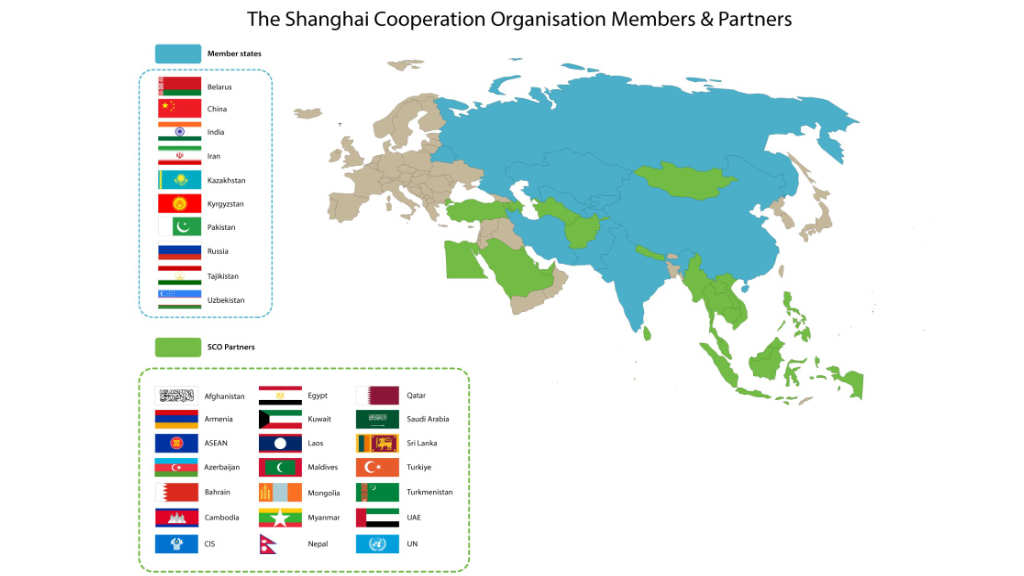
As the Shanghai Cooperation Organisation (SCO) convenes its Council of Heads of Government summit in Moscow on November 17–18, 2025, member states are poised to deliver strategic momentum on economic integration, especially in China–Russia trade and multilateral trade cooperation. Under Russia’s rotating presidency, this high-level gathering follows the landmark Tianjin Summit three months ago, and comes at a pivotal moment for Eurasian economic connectivity amid a shifting global order.
A Strategic Moment Under a Russian Presidency
Russia has formally assumed the SCO rotating presidency during this meeting, marking a deepening of the Moscow–Beijing axis and comprehensive economic partnerships at the heart of the organization. According to the Russian Foreign Ministry, the Moscow meeting will build on the outcomes of the recent Tianjin summit, using them to “substantially fill” the agenda of the Heads of Government meeting.
Already, an expert group convened virtually on November 10–12 under Russia’s chairmanship, finalizing a draft Action Plan for 2026–2030 to implement the SCO Multilateral Trade and Economic Cooperation Program. This Action Plan is set to be among the key documents adopted at the Moscow meeting.
Economic Cooperation: From Ambitious Plans to Concrete Action
A central plank of the Nov 17–18 meeting is economic cooperation. The expert group has agreed on a trade cooperation roadmap, which will be formally submitted for approval at the Council of Heads of Government summit. More than just symbolic, this plan reflects SCO members’ shared ambition to institutionalize deeper economic integration for the remainder of the decade.
For China and Russia, the two largest economies in the bloc, the stakes are particularly high. Energy cooperation, investment, and settlement mechanisms are expected to dominate discussions. These issues were prominently raised at the Tianjin summit, where President Vladimir Putin reiterated the importance of energy and infrastructure collaboration.
Of particular note is Russia’s proposal, voiced at the Tianjin meeting, to issue joint SCO bonds, as well as to build a joint payment, settlement, and depository infrastructure. These proposals aim to deepen financial integration within SCO, reduce dependence on Western financial systems, and create a more resilient internal market.
As Chinese Premier Li Qiang is also attending the 24th Meeting of the Council of Heads of Government of the Shanghai Cooperation Organization (SCO) in Moscow, expectations are rising across Eurasia for renewed vitality in regional cooperation, strengthened developmental synergy, and a shared commitment to peace and stability. SCO meetings serve as important confidence-building measures among member countries. Prime Minister Modi’s attendance at the Tianjin Summit this year could positively reshape China–India relations. Thus, member states can use this useful platform for creating good neighborly relations, regional understandings and lead to joint infrastructure projects to improve all aspects of multilateral development. Li Qiang’s engagement and meetings with participators in Moscow is likely to establish improved links with neighboring countries, with Chinese outbound investment interests to the fore as part of Beijing’s Belt & Road Initiative.
As China charts innovation and new growth drivers as its economic engine for its 2026–30 Five-Year Plan, this will create huge opportunities for SCO countries. It will also help align China’s development agenda with that of other SCO member states.
China–Russia Trade: Deepening a Core Partnership
At the heart of the Moscow meeting lies the bilateral economic relationship between China and Russia. While already extensive, their trade cooperation stands to gain fresh impetus through SCO multilateral frameworks.
One marquee project that will be discussed are the practicalities surrounding the Power of Siberia 2 pipeline, which is to channel Russian natural gas to China via Mongolia. While an MoU has been signed, only limited formal construction has taken place and the full construction schedule is still to be determined. Neither has China yet committed funding. Still, the proposal underlines the strategic long-term energy interdependence between Moscow and Beijing, a relationship that could be further reinforced under the SCO umbrella.
Beyond energy, SCO trade cooperation is expected to expand into sectors such as the digital economy, agriculture, and technology. At the Tianjin summit, Chinese President Xi Jinping highlighted the need for “local currency” trade settlements within the SCO, calling for greater resilience to external shocks and financial sovereignty. The Moscow meeting therefore presents a timely opportunity to translate that vision into practice, especially via the 2026–2030 trade action plan. As SCO leaders prepare to convene, the China–Russia economic relationship looms large at the heart of Eurasian integration. In 2024, bilateral trade between China and Russia reached a record high of US$244.8 billion, up 1.9% from 2023, according to Chinese customs data. Chinese exports to Russia grew to US$115.5 billion, a 4.1% increase, driven by surging demand for electronics, vehicles, and chemical products. Imports from Russia stood at US$129.3 billion, largely composed of raw materials—oil, timber, and fossil fuels.
China-India Trade Benefits
As the SCO Council of Heads of Government meets in Moscow, China–India economic ties also stand at a pivotal juncture. Both nations, as major regional economies, have enormous potential to drive intra‑SCO trade and strengthen Eurasian connectivity. Expanding trade in sectors such as energy, technology, and infrastructure, while exploring local currency settlement mechanisms, could reduce dependence on external financial systems and foster resilient growth. With SCO frameworks facilitating dialogue and joint projects, China and India have a unique opportunity to translate strategic partnership into concrete economic outcomes, benefiting not only bilateral trade but the broader SCO community. Bilateral commerce reached US$118.4 billion in FY 2023‑24, with Indian imports from China at US$101.7 billion and exports to China US$16.67 billion. But the trade imbalance is growing: in FY 2024‑25, India’s trade deficit with China nearly touched almost US$100 billion, driven by surging imports of electronics, solar cells, and other key goods. Within the SCO framework, Beijing and New Delhi can seize the moment to promote more balanced, sustainable cooperation across technology, supply chains, and settlement mechanisms—turning trade into long-term mutual benefit.

Intra-SCO Trade: Toward an Integrated Economic Space
While the China–Russia axis is central, the broader intra-SCO trade agenda is equally ambitious. The expert group’s Action Plan aligns with efforts to institutionalize multilateral trade flows, reduce barriers, and deepen economic links across the SCO space.
One of the key objectives is strengthening regional connectivity not only in terms of physical infrastructure, but also financial mechanisms. As multiple SCO leaders have argued, reducing reliance on the U.S. dollar and euro through local-currency settlement systems can shield members from external economic pressures.
Another important strand is the establishment of a development bank tailored for SCO members. At Tianjin, leaders agreed in principle to accelerate consultations on a joint financial institution that can fund infrastructure, energy, and social projects. While operational details remain to be hammered out, the Moscow summit may mark a significant milestone in transforming this long-standing goal into reality.
There is also institutional cooperation on non-financial platforms. For example, the SCO has signed a memorandum with Russia’s Roscongress Foundation, enabling joint congresses, forums, and expert exchanges in economic and social spheres. That arrangement could help deepen people-to-people and business-to-business ties across the region, offering new channels for trade, investment, and joint innovation.
Geopolitical and Strategic Significance
Beyond economics, the Moscow meeting sends a powerful geopolitical message. It underscores the SCO’s role as a pillar of a multipolar world order, where Eurasian powers exercise greater agency in shaping global governance.
At the Tianjin summit, Xi Jinping called for respect for “sovereign equality” and a multilateral order rooted in consensus, while rejecting hegemonic bloc politics. Putin, for his part, stressed the SCO’s growing importance in promoting regional connectivity, energy cooperation, and safe development.
Furthermore, the Moscow summit could help Russia and China further insulate their economies from Western-led economic pressures. By deepening intra-SCO settlement systems, promoting joint financial instruments, and expanding trade in local currencies, the meeting may strengthen the internal resilience of the bloc and reduce external vulnerabilities.
Challenges and Risks
However, the ambitious agenda also faces real challenges. For one, translating the expert group’s draft Action Plan into binding commitments will require political will, resource mobilization, and careful coordination. As often is the case, aligning the economic interests of ten member states (including countries with very different economic capacities) is no small feat.
Second, the idea of joint SCO bonds and financial infrastructure may raise technical, regulatory, and political hurdles: currency risk, debt sovereignty, governance frameworks, and creditworthiness of participating countries will all be scrutinized.
Third, regional fragmentation and competing priorities could complicate integration. Some analysts note that as the SCO grows, internal cohesion may be tested, especially as observer and dialogue partner states become more active.
Finally, geopolitical headwinds remain. While the SCO seeks to chart its distinct path, external pressures from Western financial sanctions to geopolitical tensions could constrain the speed and depth of practical integration.
A Forward-Looking Outlook
Nevertheless, the Moscow summit could prove a defining moment for the SCO’s economic architecture. Should member states approve the 2026–2030 trade action plan, it would establish a clear roadmap for multilateral cooperation in trade, investment, and financial mechanisms.
For China and Russia, this could translate into deepened energy ties, more robust bilateral trade, and new channels for financial cooperation that are less exposed to global volatility. For the broader SCO community, it offers a platform to institutionalize economic cooperation, support infrastructure development, and build resilience through alternative settlement systems.
On the diplomatic front, the meeting reinforces the SCO as a core institution of Eurasian cooperation — one that not only addresses security challenges but increasingly serves as an engine for economic integration.
As the SCO leaders meet, all eyes will be on their ability to convert political rhetoric into concrete, actionable outcomes. If successful, this November meeting may well mark the beginning of a new, more integrated, and economically resilient SCO for the second quarter-century of its history.
Ibrahim Khalil Ahasan is a Dhaka based independent columnist and freelance journalist, writer on contemporary international issues whose work has been published in many local and international publications.
Further Reading
The Shanghai Cooperation Organisation Reorganises: New Political Map




